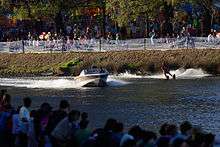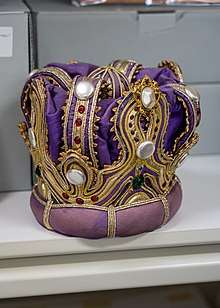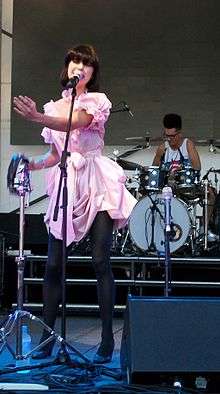Moomba
Moomba (also known as the Moomba Festival) is held annually in Melbourne, Australia. Run by the City of Melbourne, it is Australia's largest free community festival.[1] The Melburnian tradition is celebrated over four days, incorporating the Labour Day long weekend, from Friday to the second Monday in March. Moomba is culturally important to Melbourne, having been celebrated since 1955, and regularly attracts up to a million people, with a record attendance of 3.8 million (2.3 million tourists) set in 2018.
| Moomba Festival | |
|---|---|
 Waterskiing events at Moomba | |
| Genre | Carnival |
| Begins | Labour day long weekend (second Monday in March) |
| Frequency | annual |
| Location(s) | Melbourne, Australia |
| Years active | 65 |
| Inaugurated | 1955 |
| Attendance | 3.8 Million (2.3 Million tourists) (record - 2018) |
| Organised by | City of Melbourne |
| Website | https://moomba.melbourne.vic.gov.au/ |
In 2003, the event was renamed Melbourne Moomba Waterfest and is centred on the Yarra River.
Traditional events include the Moomba parade, crowning of Moomba monarchs, fireworks displays, carnivals in the gardens along the river, river activities including watersports, water floats and the birdman rally, as well as live music and bands.
Origins
In 1951, Australia celebrated fifty years of Federation with a parade and the staging of the theatre production "An Aboriginal Moomba: Out of the Dark". In 1954, Queen Elizabeth II visited the city for the first time as reigning monarch, and the City Development Association and the Melbourne City Council proposed an autumn carnival to be known as "Moomba".[2] A committee was formed in July, 1954 to organise and fund the event, successfully allocating £10,000 to its inaugural running. Before the event's first year, controversy was created when Labor Councillor Frank Williams resigned from the committee, branding the planned carnival as a "Bourke street joke for the benefit of shopkeepers".[3] A promotional theme song "Come to Melbourne for the Moomba" was written by Jack O'Hagan.
Etymology
The festival was originally named Moomba by organisers in the belief it was a native word meaning 'let's get together and have fun.' Credit is usually given to Bill Onus, a unionist and member of the Australian Aborigines' League for proposing the term, which he used in a play, Aboriginal Moomba in 1951.[4] In 1969 Luise Hercus glossed the word mum (rhyming with 'vroom')[5] as meaning 'bottom, rump', and suggested mum-ba meant something like 'bottom and..', and had been introduced from Healesville usage as a joke.[6] In 1981 Barry Blake analysed the word as combining as mum (anus) and –ba, a locative suffix meaning ‘at, in, on'. This would give the sense of 'up your bum/arse'.[7][8]
Onus himself, according to his daughter-in-law, who said she had heard the story from Onus's wife Mary, had picked up the word from a word list of indigenous terms.[4] Some say he did it to get back at the city council for having deliberately upstaged the traditional Labour Day march with a popular carnival. Lin Onus, his son, stated that indeed his father had intended to play a prank in passing on the word with this sense.[5]
Event history


The first Moomba was a 15-day festival officially opened on 12 March 1955 by the State Governor, Sir Dallas Brooks.[9] The inaugural programme included a fireworks display, parade, vintage car display, Henley rowing regatta, river floats including a "Lord Mayor's houseboat", cycling race, tennis at Kooyong, concerts including performances by the Victorian Symphony Orchestra and Royal Philharmonic choir, crowning of the Queen of Moomba and riverside carnival. 25,000 turned out to watch the inaugural Moomba parade down Swanston Street. The first Moomba was heavily criticised by Melbourne's conservative establishment, including the Anglican Church, which at the time claimed it was hedonistic and embodying social decay.[10] Council responded to the criticism citing that Moomba was intended to be a festival for families and as such is reinforcing family values in society.[11]
After the 2016 Moomba festival fireworks there was a large-scale brawl in and around Federation Square in Melbourne's Central Business District, largely between members of two gangs, Apex and Islander 23.[12]
Events
Parade and floats
A parade (or "procession") and floats through the streets of Melbourne have been a key part of the Moomba festival since its beginning. Each year it attracts over 100,000 people to Melbourne's city centre as well as being shown on free-to-air television in Melbourne.
The first Moomba procession was held in 1955. It was first televised in 1957, the year after the Melbourne 1956 Olympics.

The floats have an annual theme, usually an elaboration on "Let's get together and have fun", the avowed mission and vision statement of Moomba and are usually from sister cities (of which Melbourne has six), schools and community groups. They also promote some aspect of the arts, like singing, dancing, or design. Swanston Street is the traditional home of the floats and spine of the city and horse- or tractor-drawn floats use the tram tracks. Decorated trams are sometimes also featured.
In 2001, the parade came under media controversy when a French Troupe and Melbourne's Snuff Puppets had floats with naked people covered in body paint.
Moomba monarchs
_Melbourne_(13054867724).jpg)
The Moomba monarchy has been one of the most celebrated and controversial components of the festival over the years.[13]
In 1999 the tradition ended when clowns Zig and Zag were appointed. After it was revealed that, years before, Zig (Jack Perry) had pleaded guilty to child molestation, they were dethroned. In 2010 the tradition was finally restored after 11 years with Molly Meldrum and Kate Ceberano being named King and Queen of Moomba [14]
- 1980 Paul Cronin and Elizabeth Egan
- 1981 Lou Richards and Kim Formosa
- 1982 Frank Thring and Sharon McKenzie
- 1983 Daryl Somers and Linda Knight
- 1984 Kevin Bartlett and Kim Kermonde
- 1985 Ian 'Molly' Meldrum and Anne Erikson
- 1986 Peter Brock and Ingrid Johansen
- 1987 Paul McNamee and Marita Jones
- 1988 Jo Pearson
- 1989 Con the Fruiterer
- 1990 David Hanison
- 1991 Tony Shaw
- 1992 Don Dunstan
- 1993 The Oarsome Foursome
- 1994 Andrew Gaze
- 1995 Cathy Freeman
- 1996 Marina Prior
- 1997 Lano and Woodley
- 1998 Denise Drysdale
- 2010 Ian 'Molly' Meldrum and Kate Ceberano
- 2011 Mick Malthouse and Ruby Rose
- 2012 Harry Kewell and Natalie Bassingthwaighte
- 2013 Community and Emergency Services[15]
- 2014 Bert Newton and Lucy Durack
- 2015 Shane Warne and Pallavi Sharda
- 2016 Michelle and Stevie Payne
- 2017 Guy Grossi and Karen Martini
- 2018 Jimmy Giggle (aka Jimmy Rees) and Chrissie Swan
- 2019 Archie Thompson and Jane Bunn
- 2020 Julia Morris and Nazeem Hussain
Queen of Moomba (1955 to 1987) from Beverley Stewart to Marita Jones.[16] Won by a beauty pageant competition. 1966 Moomba Queen Erica McMillan was killed in a car accident seven weeks after the festival, in the car which she had received as a prize for being voted Queen.[17]
Queen of the Pacific (1967–1977) from Betty Lim Saw Yim (as Princess of Malaysia) to Lei Maa (Princess of Hawaii).[16]
King of Moomba (1967 to 1987): British actor Robert Morley (1967), British actor Alfred Marks (1968), Italian opera singer Tito Gobbi (1969), featherweight boxing champion Johnny Famechon (1970), Russian clown Oleg Popov (1971), pop singer Johnny Farnham (1972) with Collingwood footballer Lou Richards as his Jester, indigenous Pastor Sir Douglas Nicholls (1973), ballet dancer Sir Robert Helpmann (1974), entertainer Rolf Harris (1975), entertainer Barry Crocker (1976), Disney character Mickey Mouse as King of Moomba and TV Personality Ugly Dave Gray as a Jester (1977), first Melbourne born king, entertainer Bert Newton (1978), entertainer Graham Kennedy (1979), TV actor Paul Cronin (1980), Lou Richards again but this time as King (1981), film, TV and stage actor Frank Thring (1982), TV Personality Daryl Somers (1983), footballer Kevin Bartlett (1984), TV Personality Ian "Molly" Meldrum (1985), motor racing driver Peter Brock (1986) and champion doubles tennis player Paul McNamee (1987).[13] Another source lists Gobbi (1968), Marks (1969) and Richards as Jester (1971).[16]
Young Ambassador (2003–2009): Carrie Stoney, Sam Quinn, Alan Wu, Natalie Bassingthwaighte[16] and Trisha Broadbridge.[18]
From approximately 1981–1988 there were also instances where Moomba included a Prince and Princess of Moomba designation consisting of two children chosen through a competition held by local radio station 3KZ.[19]
Fireworks
Fireworks are a big part of the Moomba festival and large displays occur on every night of the festival .The fireworks are above the Yarra river.
Carnival
A traditional carnival including a ferris wheel are held in the Alexandra Gardens along the river bank. In recent years, the carnival has extended to Birrarung Marr across the river. It is popular with children, and dagwood dogs and doughnut stands line the paths.
River activities
Moomba particularly celebrates the Yarra River, which has been much maligned during the history of the city until the last few decades.
Water skiing

Water skiing in the Yarra was introduced to Moomba in 1959. The tournament has both Junior and Open divisions, with the finals crowning the Moomba Masters Champions on Moomba Monday.
River floats
The festival has featured Chinese dragon boats and the Moomba Showboat.
Birdman rally
Among the more popular events is the Birdman Rally, begun in 1976,which is traditionally held at the Swan Street bridge over the Yarra River. However it has been held only intermittently during Moomba's history. It was stopped for a number of years due to high levels of E. coli contamination of the Yarra. Subsequent clean-ups reduced pollution to acceptable levels and 2004 saw its return. In 2005 the rally was held in the new inner city park, Birrarung Marr, close to its traditional location.[20][21]
Music and live bands

Moomba's performers have included international musical acts such as ABBA, Neil Diamond and AC/DC as well as a number of smaller local acts.
In 2012, performers included Tex Perkins and Daryl Braithwaite.
Citations
- Powley 2017.
- "'Moomba' gala next year". The Argus. 13 May 1954. Retrieved 16 October 2016.
- pg4. The Argus Wednesday 1 December 1954
- Dubecki 2008.
- Kelly 2011.
- Hercus 1969, p. 371.
- Moore 2001, p. 131.
- Blake 1981, p. 84.
- "It's a gay day today". The Argus. 12 March 1955. Retrieved 16 October 2016.
- "With the Churchmen: 'Moomba spirit leading us to decay". The Argus. 14 March 1955. Retrieved 16 October 2016.
- "Councillor defends Moomba". The Argus. 15 March 1955. Retrieved 16 October 2016.
- Melbourne street brawl blamed on Apex gang after Moomba festival Sunday March 13, 2016. The Guardian Retrieved May 18, 2016
- Craig Bellamy, Gordon Chisholm, Hilary Eriksen (17 Feb 2006) Moomba: A festival for the people.: http://www.craigbellamy.net/images/moomba.pdf PDF pp 17-22
- Barry, Evonne (16 February 2010). "Molly Meldrum and Kate Ceberano the new king and queen of Moomba". Herald Sun. Retrieved 12 July 2020.
- "Moomba 2013". Archived from the original on 21 February 2013. Retrieved 18 February 2013.
- "Moomba Monarchs". Archived from the original on 14 July 2009. Retrieved 25 April 2012.
- "Beauty Queen Killed in Car Smash". Google News. Sydney Morning Herald. 1 May 1966. Retrieved 12 July 2020.
- Mary Bolling & Matthew Schulz, (12 Mar 2007) Moomba thrills young and old: http://www.news.com.au/story/0,23599,21366832-421,00.html article from Herald Sun
- Walker, R. R (1984). Dial 1179: The 3KZ Story. Curry O'Neil. p. 197. ISBN 9780855505967. OCLC 12663214.
- "Moomba Birdman Rally 2020". www.onlymelbourne.com.au. Retrieved 9 May 2019.
- "Is it safe to swim in the Yarra River?". ABC News. 25 May 2018. Retrieved 9 May 2019.
References
- Dubecki, Larissa (8 March 2008). "Let's have fun, said some, and name a festival 'Up Your Bum'". The Age.CS1 maint: ref=harv (link)
- Kelly, Piers (14 March 2011). "Does 'Moomba' really mean 'up your bum'?". Crikey.CS1 maint: ref=harv (link)
- Moore, Bruce (2001). "Australian English and Indigenous Voices". In Blair, David; Collins, Peter (eds.). English in Australia. John Benjamins Publishing. pp. 133–150. ISBN 978-9-027-29799-0.CS1 maint: ref=harv (link)
- Hercus, Luise A. (1969). The Languages of Victoria: A Late Survey, Issue 6, Part 2. Australian Institute of Aboriginal Studies.CS1 maint: ref=harv (link)
- Powley, Kathryn (10 March 2017). "Moomba 2017 guide: Melbourne's 'free community festival' has arrived". Herald Sun.CS1 maint: ref=harv (link)
Other reading
Eckersley, M. 2012. 'Australian Indigenous Drama'. Tasman Press. Altona.